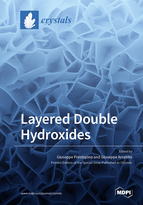Layered Double Hydroxides
A special issue of Crystals (ISSN 2073-4352). This special issue belongs to the section "Inorganic Crystalline Materials".
Deadline for manuscript submissions: closed (30 April 2020) | Viewed by 54722
Special Issue Editors
Interests: thin film technology; chemical vapor deposition synthesis; synthetic diamond; self-assembled nanomaterials; layered double hydroxides; electrical and optical properties
Special Issues, Collections and Topics in MDPI journals
Interests: Molecular printing; 3D Printing; Dip Pen Nanolithography; Atomic Force Microscopy; Microfluidics; Nanowires; Fluorescence lifetime; nanomaterials/DNA/aptamer-based sensor; POC devices; DNA/aptamer; enzymes; biosensor design; medical applications; food and environmental applications
Special Issue Information
Dear Colleagues,
Two-dimensional (2D) materials constitute a versatile platform for the realization of a new class of functional systems showing unique enhanced surface effects and unprecedented tuneable confinement and geometry-related properties which can open up important applications in very different fields, namely surface chemistry and catalysis, band-gap engineering, photovoltaics, energy storage, harvesting and conversion, nanomedicine, spintronics and valleytronics. Many 2D materials with very different natures have been described in detail for these applications, such as graphene, silicene, phosphorene, hexagonal boron nitride (h-BN), transition metal dichalcogenides (TMDs), metal organic frameworks (MOFs), layered oxides and hydroxides, and DNA origami. Although the proof-of-principle for their outstanding functionality has been demonstrated, the ultimate hurdle for 2D materials to be implementable in technological applications is the ability to find reproducible, green-chemistry, environment friendly and low-cost approaches for their synthesis and subsequent functionalization at large scale and low cost. Among the up-to-date 2D materials, layered double hydroxides (LDHs) have attracted a huge research interest in the last years, with more than 2000 papers published in the last five years. LDHs are low-cost materials, and can be easily synthetized as self-assembled hierarchical nanosheet thin films and exfoliated up to the monolayer limit. LDHs are therefore a playground for exciting new research covering all of the most intriguing features of 2D materials and more.
The aim of this Special Issue is to provide a unique international platform that can enable scientists to publish the latest advancements on the following topics:
- Novel approaches to the controlled synthesis of inorganic, organic and biomolecular 2D materials (green chemistry, low temperature), with particular emphasis on the implementation of large-scale fabrication of devices, wet-chemistry and water-dispersible 2D material formulations.
- The synthesis, characterization, and functionalization of LDHs, including all contributions focusing on properties and applications of self-assembled hierarchical LDH nanosheet thin films and LDH exfoliation to monolayers, according to a multidisciplinary approach.
- Other 2D material monolayers, layered materials, Van der Waals heterostructures.
- Physical, chemical, and optical characterization of 2D materials and exploitation of their outstanding features for device fabrication and integration in complex systems.
Dr. Giuseppe Prestopino
Dr. Giuseppe Arrabito
Guest Editors
Manuscript Submission Information
Manuscripts should be submitted online at www.mdpi.com by registering and logging in to this website. Once you are registered, click here to go to the submission form. Manuscripts can be submitted until the deadline. All submissions that pass pre-check are peer-reviewed. Accepted papers will be published continuously in the journal (as soon as accepted) and will be listed together on the special issue website. Research articles, review articles as well as short communications are invited. For planned papers, a title and short abstract (about 100 words) can be sent to the Editorial Office for announcement on this website.
Submitted manuscripts should not have been published previously, nor be under consideration for publication elsewhere (except conference proceedings papers). All manuscripts are thoroughly refereed through a single-blind peer-review process. A guide for authors and other relevant information for submission of manuscripts is available on the Instructions for Authors page. Crystals is an international peer-reviewed open access monthly journal published by MDPI.
Please visit the Instructions for Authors page before submitting a manuscript. The Article Processing Charge (APC) for publication in this open access journal is 2600 CHF (Swiss Francs). Submitted papers should be well formatted and use good English. Authors may use MDPI's English editing service prior to publication or during author revisions.
Keywords
- green chemistry
- surface chemistry
- hydrothermal synthesis
- catalysis
- energy conversion
- layered double hydroxides
- LDHs
- 2D materials
- bottom-up, top-down, exfoliation
- heterostructures and layered composites
- quantum confinement
- ionic conductivity







